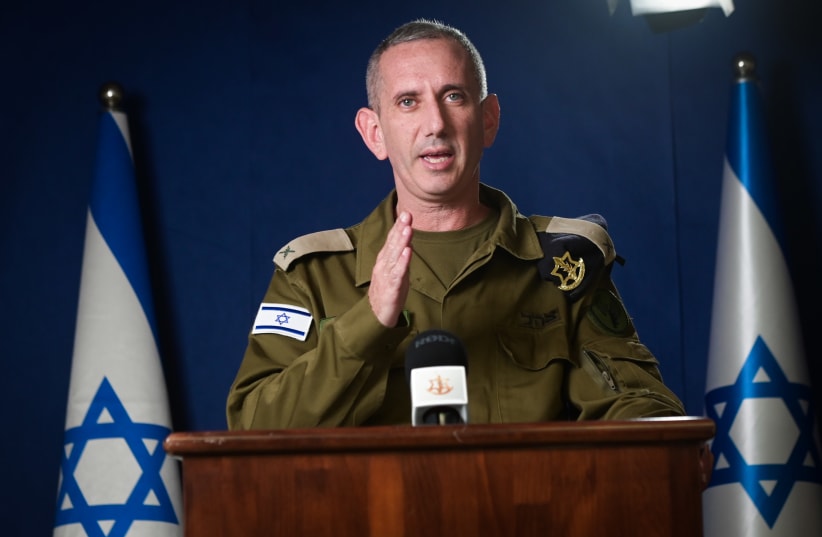News
‘Hezbollah is endangering you’: Hagari warns Lebanese near terror targets to flee South Lebanon

Hagari’s warning was unusual and different from mass evacuation warnings issued to date in Gaza.

The IDF, around 6:30 a.m. on Monday, initiated a fifth round of massive air strikes on Hezbollah, especially in southern Lebanon, including further from the border than in some prior cases. Starting Monday morning, the IDF has attacked over 150 targets using dozens of fighter jets from all Air Force squadrons.

There were also significant attacks against Hezbollah deep into Lebanon in the Bekaa Valley.
IDF Chief Spokesman Daniel Hagari, for the first time, issued a broad warning to the general public in southern Lebanon that if they have not already moved away from houses and other civilian buildings where they live and reside – but where Hezbollah has stored rockets or undertaken other actions – now they must leave those areas.
Hagari’s warning was unusual and different from mass evacuation warnings issued to date in Gaza.
The warning was the first sort of mass evacuation warning to southern Lebanese regarding areas where Hezbollah is operating.
Continuing in that vein, hundreds of thousands of southern Lebanese civilians have evacuated areas that the IDF has been attacking already for several months.
So, a warning was issued to those who have not yet evacuated.
Footage of the strike on the cruise missile, the terrorists, and the house where the cruise missile was located (IDF)
Not a complete evacuation
However, the IDF did not tell the southern Lebanese civilians that they must completely leave the area to move to some other further away specified area.
It was not clear where the IDF would suggest these evacuating civilians should go permanently if, in fact, their homes were to get bombed due to holding terror assets.
Also, it was not like a Gaza evacuation, as Hagari did not yet suggest that the IDF would be invading with ground troops, but more that it would be striking with additional intensity from the air, including at civilian locations where terror assets have been located.
To illustrate his point, Hagari displayed an example of a southern Lebanese civilian location where the IDF, a few weeks ago, watched Hezbollah knock down some of the walls in order to set up a camouflaged civilian location for the firing of a Russian-made DR-4 cruise missile, with hundreds of kilos of explosives.

Tharwting of a Hezbollah crusie missile ready to launch, September 23, 2024 (credit: IDF SPOKESMAN’S UNIT)
“We are exposing Hezbollah’s tactic of hiding a cruise missile inside a residential home. The terrorists created a designated opening to launch the missile,” Hagari explained.
Hagari said that the cruise missile, a much larger danger than typical Hezbollah rockets because it flies lower and faster in a line-drive type fashion as opposed to rockets, which fly slower and in an arch trajectory, had been smuggled to Hezbollah via Syria.
Next, Hagari showed the IDF watching Hezbollah terrorists exiting the area.
Finally, he showed the IDF blowing up both the cruise missile and the civilian location where it was hidden, along with the Hezbollah terrorists.
“Here, you can see how we identified the terrorists as they made an opening in the building, revealing the missile. In a precise strike, the IDF neutralized both the terrorists and the missile launch infrastructure just moments before the planned launch,” Hagari explained.
One of the purposes of Hagari’s public statements, which have subtitles in Arabic, was to broaden the warning to southern Lebanese civilians to leave such areas, while another purpose was to preempt Western criticism for targeting civilian areas, to explain the IDF’s justification.
Under international law, civilian areas can be targeted if warnings are provided and if those areas have been used for military purposes.
In addition, the IDF said that it had shot down attempted aerial attacks from Iraq around 4:00 a.m.
Hagari’s warning
Hagari, warning the Lebanese civilians, emphasized, “Hezbollah is endangering you and your families. Hezbollah is planning to launch weapons against Israel, and you should distance yourselves immediately for your safety.”
“We are exposing Hezbollah’s tactic of hiding a cruise missile inside a residential home. The terrorists created a designated opening to launch the missile,” he added.
Furthermore, the IDF sent out text messages to the southern Lebanese citizens urging them to stay away from Hezbollah structures, Israeli media reported.
“If you are in a building containing Hezbollah weapons, move away immediately until further notice,” the text message sent to the civilians reportedly read.
According to a Reuters reporter, shortly afterward, residents in southern Lebanon also received calls from a Lebanese number ordering them to immediately distance themselves 1,000 meters from any Hezbollah post.
Additionally, Haragi addressed the evacuated citizens of Israel’s North, stating that he “will do whatever is necessary to restore citizens to their homes and ensure their safety.”
“We will do whatever is necessary to restore northern citizens to their homes. We are operating on an undercover operation, and we continue to do so to protect the citizens of Israel,” Haragi emphasized.
Hezbollah’s human shields
According to Ynet, ten years ago, Hezbollah launched a secret initiative to offer financial incentives to Shia households in southern Lebanon if they allocated a room of their house to a long range missile launcher. The missile, with a heavy warhead, would be ready to launch from that room. The room would have a removable roof, allowing it to be fired quickly.
Ynet added that Hezbollah specifically chose poor Shia families who needed extra income. Reportedly, Hezbollah purchased plots of land and constructed residential homes on them, offering them at a reduced price of for free if the families were willing to store missiles.
Can neither confirm nor deny if Sinwar is alive
When Hagari was asked about the last time the IDF received a sign of life from Hamas Head Yahya Sinwar, Hagari responded that he could neither confirm nor deny if Sinwar was alive.
This question from the press toward Haragi came after circulating speculations and reports on Sunday that Sinwar had been killed.
“Regarding what has come up in the past days about Sinwar’s situation, I can neither confirm nor deny it,” Hagari stated.
“We have one mission—to reach Sinwar, and we will,” he emphasized.

News
Akpabio, Bello plot to assasinate me – Natasha gives shocking details

Senator representing Kogi Central Senatorial District, Natasha Akpoti-Uduaghan on Tuesday revealed how plot to recall and assassinate her was hatched on 12th March, 2025 in Abuja.

Narrating her ordeal when she paid Sallah visit to her Senatorial District in Kogi, the lawmaker who has been suspended for six months by the 10th Senate over alleged breach of Standing Rules of the Senate told the mammoth crowd that Senate President, Godswill Obot Akpabio got the former Governor of Kogi State, Yahaya Bello involved to perfect strategies to recall her from the Senate.

She said, the plan took place at Transcorp Hoteon the night of 12th March at about 10pm, where Bello was told to ensure that she was eliminated outside Abuja to avoid suspicion.
She explained:: “Mind you, on the 12th March, 2025 at about 10pm, Godswill Akpabio had called Governor Ododo to tell him that he should commence my recall, but Ododo told him, it will be impossible to do that.
“This is what Governor ododo said on the 12th. Listen. Ododo told him it is impossible because the masses are with her. But Akpabio wasn’t satisfied, he then sent for Yahaya Bello and it was Senator Asuquo from Cross River State that trailed Yahaya Bello from Transcorp Hilton.
“I was told of everything that happened.
They told Yahaya Bello to commence my recall that he was going to fund. Of course, money exchanged hands that night.
“The second thing they told him was that he should try and kill me. I didn’t make this public, but I wrote to the Inspector General of Police.
“Akpabio told Yahaya Bello that killing me doesn’t happen in Abuja. It should happen here (Kogi) so that it will look as if my people killed me here.
“I didn’t make that public, but we did notify security agencies.”
The lawmaker told her constituents that she ws removed as Committee Chairman on Local Contents angrily by the Senate President because of the Liquefied Natural Gas plants she influenced to Ajaokuta.
“Why they removed me as Chairman of Senate Committee on Local Content was because of Gas plants which I influenced. Akpabio called members of his cabinet and questioned them on why the resources found its way here.
“He said I am using Niger Delta resources to promote the North and said he will stop it.
“I will prove to you what he did. After the Senate President removed me, of course it is because of five NLNG projects. He said ever since he made me Chairman of Local Contents, I have used that office to promote the north.”

News
South East: Ebonyi Governor orders arrest of 6 Commissioners, LG Chairman over conract breach

Six Commissioners and a Local Government Council Chairman have been arrested on the order of the Governor of Ebonyi State, Mr Francis Nwifuru over alleged breach of contracts.

The Chairman Afikpo Local Government Area, Mr. Timothy Nwachi, was suspended from office with immediate effect.

Reports said, the Commissioners were accused of contractual breach in the ongoing construction of 140 housing units for the Izzo and Amaze communities, which were displaced by the Ezilo/Ezza Ezilo communal crisis in Ishielu Local Government Area.
The names of embattled Commissioners are: Professor Omari Omaka (Tertiary Education), Victor Chukwu (Environment), Ifeanyi Ogbuewu (Culture and Tourism), Uchenna Igwe (Local Government and Chieftaincy Matters), Moses Ekuma (Health), and Felix Igboke (Project Monitoring).
They were first declared wanted following their disappearance from the State Executive Committee meeting when the matter became known in the media, and the Ebonyi State immediately launched manhunt before they were eventually arrested.
Commenting on the development, Ilang Donatus, Chairman of the State Executive Council Committee on the Izzo and Amaze Housing Project, stated that the action was taken due to the officials’ and contractors’ failure to adhere to contract terms.
Donatus noted that the officials are delaying the housing project, which Governor Nwifuru had planned to commission in celebration of his second anniversary in office.
Donatus emphasised the governor’s frustration over the slow pace of construction, noting that the housing initiative was designed to provide relief to victims of communal crises.
He was quoted as saying, “The governor is not happy over the pace of the work, which ought to have been completed. The government has decided to clamp down on the contractors and commissioners who were mandated to supervise those projects.
“As you can see, our governor is a man with a passionate heart, he likes giving succour, hence the building of those houses for the victims of the communal crisis. He is not happy that the project is delayed and has ordered to arrest of all the commissioners who are supposed to ensure the speedy completion of the housing units.
Adding to the concerns, Mrs. Maria Okohu, Special Assistant to the Governor on Women Mobilization (Ebonyi Central) and a member of the Executive Council Committee, described the situation as an act of sabotage.
She stressed that failure to complete the housing project on schedule undermines the governor’s development agenda for the state.
In response, the state government has vowed to continue its crackdown, warning that further arrests will be made until all implicated commissioners and contractors are held accountable.
Reports also suggest that the Nigerian police have issued invitations to several officials who were not present during the committee’s enforcement visits.
Upon inquiry, Ebonyi State Police Public Relations Officer, SP Joshua Ukandu, stated that he had no knowledge of the arrest or detention of the accused commissioners and the suspended council chairman.
When questioned about whether the Command had invited the officials following the governor’s directive, the police spokesperson responded, “We don’t have any commissioner in our custody. I’m not aware of any invitation and I have asked and I was told we don’t have any commissioner in custody. I will still ask about the invitation but for now, I don’t know anything of such.”

News
Ododo’s aide escapes assassination by whiskers, allege APC youth leader, Mohammed behind attempt

Gov. Usman Ahmed Ododo’s Aide, Hon. Godfrey Adekoye, Senior Special Assistant on Youths Empowerment on Tuesday escaped an assassination attempt on his life by whiskers.

The aide of the Governor said the attack on his life happened at Lounge 1, a popular hospitality joint in Lokoja, added that the attackers followed him down to his house, unfortunately they met his absence.

In a statement he made available to CAPITAL POST in Lokoja, the aide to the Governor accused the Kogi State APC Youth Leader, Hon. Mohammed U Mohammed and one Abubakar Nasara Ola as behind his attack.
He said during the attack on him, Abubakar threatened to kill him, pointed a gun at him before the intervention of onlookers who saved him by chance.
The attackers destroyed and broke the windscreen of his vehicle, that is now parked in the custody of the Quick Response Squad.
Speaking on the attack, Hon. Godfrey said he has since reported the matter to the Quick Response Squad, an arm of the Nigerian Police, in Lokoja, said his life is in danger.
When contacted, the Police Public Relations Officer, SP Williams Ayah, said he was making efforts to confirm the attack on the aide, could not be reached as at time of going to press.

-

 Security4 days ago
Security4 days agoNew Commissioner of Police in Niger, Elleman sends strong warning to criminals
-

 News3 days ago
News3 days agoAbia: LG Chairman, Iheke accused of using soldiers to detain IRS agent, claims Governor Otti’s support
-

 News4 days ago
News4 days agoKogi Governor, Ahmed Usman Ododo salutes Tinubu at 74
-

 News4 days ago
News4 days agoPlateau LP stakeholders endorses Barr Gyang Zi’s defection to APC
-

 News4 days ago
News4 days agoAkpabio pays historic visit to office of SA to President on Senate Matters
-

 News1 day ago
News1 day agoKogi government bans rallies ahead of Natasha’s homecoming slated for Tuesday
-

 Business4 days ago
Business4 days agoFCT Minister reveals how he would aggressively pursue revenue collection, tours infrastructure
-

 News1 day ago
News1 day agoIran may secure a deal before Trump’s deadline – or face Israeli strikes in Tehran – analysis





















